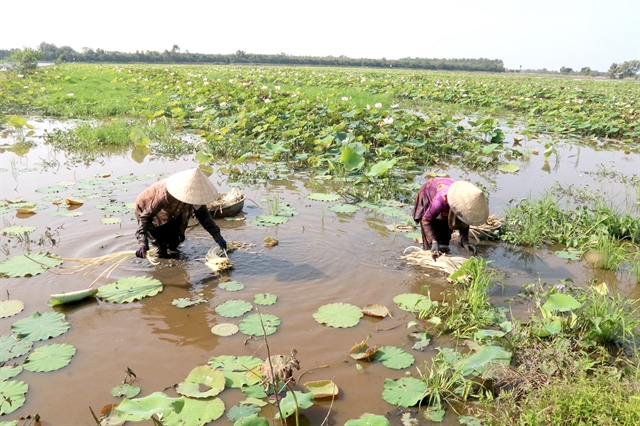 Society
Society

 |
| Farmers in Thạnh Hoà Commune in Tiền Giang Province’s Tân Phước District harvest lotus stems planted in the flood season. – VNA/VNS Photo Minh Trí |
TIỀN GIANG – Farmers in Tiền Giang Province’s upstream areas have effectively implemented farming models during the flood season to earn high incomes.
The Cửu Long (Mekong) Delta province is in the flood season which is caused by the rising level of the Mekong River in the rainy season.
Fields for growing rice and other crops in the upstream areas of the Tiền River, a tributary of the Mekong River, in Tân Phước, Cái Bè and Cai Lậy districts are inundated by flood water.
Trương Văn Xinh, chairman of the Thạnh Hoà Commune People’s Committee in Tân Phước, said the flood water levels in these fields are 0.5 metres higher than during the same period last year.
The flood season brings in natural aquatic species and sediments to fertilise the soil of the fields.
Farmers in the commune have taken advantage of flood waters to implement farming models such as growing lotus and breeding aquatic species, he said.
Phan Thị Thanh Nhung in Thạnh Hoà’s Hoà Xuân Hamlet has rotated growing rice and lotus in her 1.5ha field for many years.
She grows rice in the winter-spring season and lotus in the flood season every year.
She chooses to grow lotus as it is easy to grow and requires less investment cost, she said.
She earns a profit of VNĐ70-80 million (US$2,800-3,200) per hectare of lotus in a growing period of five to six months, she said.
Thạnh Hoà has about 150ha that are growing lotus and other crops in flooded fields, and it estimates a total harvest output of 2,400 tonnes, according to the commune People’s Committee.
The cultivation of aquatic species and other crops in the flood season has created part-time jobs for hundreds of labourers in the commune, it said.
Thạnh Hoà is the first commune in the province’s Đồng Tháp Mười (Plain of Reeds) low-lying region that was recognised as a new-style rural area in 2017 and an advanced new-style rural area in 2020.
In flood-prone areas in Cai Lậy District, more and more farmers have developed fresh-water aquaculture to adapt to climate change.
Hà Văn Lợi in Cai Lậy’s Mỹ Thành Nam Commune has switched from growing two rice crops a year in his 2,500 sq.m field to breeding ornamental fish.
He now earns a profit of more than VNĐ350 million ($14,000) a year, many times more than growing rice, he said.
Nguyễn Văn Giáng, secretary of the Mỹ Thành Nam Party Committee, said dozens of farmers in the commune have learned Lợi’s ornamental fishing farming and implemented it.
The model is suitable with the locality’s natural conditions and offers high income, and this helps farmers to have stable lives, he said.
The commune is taking procedures to establish an ornamental fish farmers club to exchange experiences among farmers and expand ornamental fish farming.
The delta’s flood water levels have trended to decline in past years and more rice farmers in the province have switched to farming models that adapt to the changes of flood water.
Farmers have expanded effective farming models such as rotating the cultivation of rice and lotus, rice and fish, or switching completely to cultivating fruits or aquatic species that suit with the natural conditions of each locality, according to the province Department of Agriculture and Rural Development.
Nguyễn Văn Mẫn, director of the department, said the department is supporting farmers to expand these models by zoning farming areas, providing them farming techniques and boosting the application of science and technologies in agriculture production.
It has strengthened the development of agricultural co-operatives and co-operative groups and increased trade promotion activities for key agricultural products, he said. – VNS




